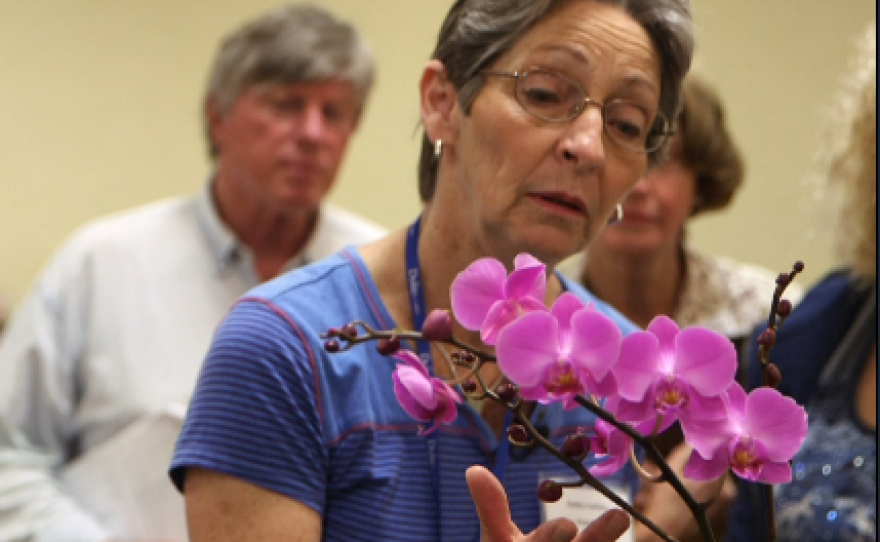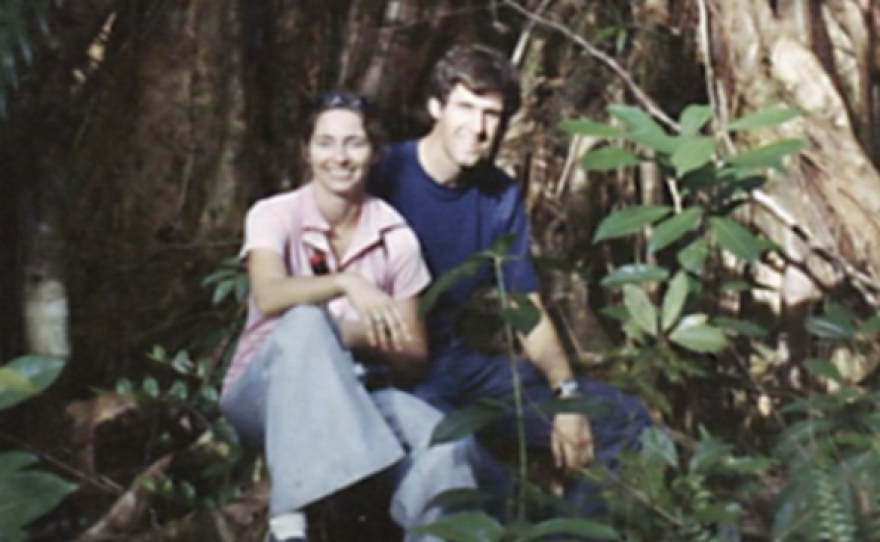A few dozen adults crowd around tables in a large conference room at the Scottish Rite Center in Mission Valley. At the front of the room a grey-haired woman shouts a greeting.
They have been admired for centuries as strange spectacular flower basket like Phil has made the subject of myth and legend and so today they feel there is something mysterious about them the mystery is replaced by devotion at the San Diego County orchid society. KPBS reporter Tom five spoke with ready the organization celebrates its 70th anniversary. Tell me a story that you told when we talked on the phone how you first became interested in orchids. My husband and I lived in Long Beach at the time it was probably in the early 80s and one day he comes running home with a piece of orchid and it was something like this, it's called an evident from a comes running home with a piece of something that looks like this piece rate year and so it has no flowers on it whatsoever that this part but this, he comes running Romany said look what I found in the alley it was in someone's trash can it's an evident from. It's an orchid. I said no that's not an orchid that's just an ugly piece of lands. He went through this whole process of telling me that this plant was an orchid for sure and he was going to prove it to me. I said okay. Go-ahead improve it to me. Later I can show you got right back here is a rock is moth on it and he has had that for like 40 years so he says I'm in a but this piece of land on that Moss rock but it's gonna grow and bloom and I'm in the show you. So it bloomed and it was this beautiful red plant with a ball and I should do we look like, and this Blooming in blooming and then another one came up and bloomed in bloomed and it continued to bloom until I just discarded in a little while ago. So for all of its life it was in continuous bloom. So he found the plants and as far as you in orchids go the rest is history. I was taken by. We started looking for different orchids and we were going trips and we go to orchid vendors and houses the nurses in the or you know it I found the most beautiful orchid I had ever seen and it was called a master vilayet BT on a and this was the killer for me. It was the reason to go and grow orchids. What is it about orchid sky when you like orchid so much why would you -- what would you tell someone who asked that? There are so many different types of them and they are so perceivable he difficult to grow that it is a challenge to try to not just get a and see it in bloomed but then to reblooming again in an environment that is not's its traditional environment. So like my favorite grows in Peru but if I can bloom that that is a success for me. Watching it and waiting for it to bloom is so exciting, it's a process of watching and realizing that you read bloomed it. You live in Point Loma, is that a good place to grow orchids? It is in fact people think that it is the best ways to grow orchids because there is enough Marine layer it's a nice temperature that you can grow most of everything. But most importantly I can grow a masdevallia veitchiana because it does stay cool during the day is about 10 degrees cooler so I can grow lots of good things here. When you say orchid to your average person they have probably seen them sold at Trader Joe's or something like that, do you think that people have misconceptions about orchids and what they are? Yes because what they do see at Trader Joe's or anywhere else are some of the easier ones to grow that are hybrids, and they think they are usually big flowered and show we and they are very exciting. But orchids are really the tiniest little flour to the biggest flowers and they grow all over the world that Fremantle that. That misconception also means they think that they are hard to grow and so they are afraid to start growing them because they think they will kill them. Orchids grow all over the world so it may be tempting to say it is a tropical plant but it is not a tropical plant is kind of an everywhere plan. Absolutely. It is not at all tropical, not all of them cost him of them are they will need warmer places at but some of them grow in mountaintops. Some of them grow in the grounded have to get a free be able to bloom the next year they grow in Alaska were other high elevations or Germany or France or other locations. You are right, they grow at all temperatures except for in Antarctica. You know I ask you what it is and about orchids and I kind of want to ask you what is it about orchid people? Where orchid people and what do they have in common? One of the things I found very interesting about my very first orchid society meeting because I grew orchid for about 20 years before I joined the society, my very first time that I went what I was struck by is the fact that these people were curious, intellectual in a very strange way, they are a little bit strange because to tell you the truth, workers growing tends to be a bit of an obsession and you can get addicted to it and we all know we are trying to recover and not by the next orchid we see. But they love the science of growing orchids, they love the challenge of it, so they have this great engagement with a plant, with a flower, and it seems very strange but it is very endearing because the excitement from them when they bloom a plant or when they grow something that draws you write in. You cannot help yourself you'd love it. You are the vice chair of the conservation Society what is it called? Conservation committee of the San Diego orchid society. What does the society do? What are you concerned about? We are concerned about the loss of orchids in the wild and that is because whether they are clearcutting forests in the Amazon or whether they are building houses or using some thing for foreign lands -- farmland, orchids go extinct. We want to do a number of things to keep them from going extinct and to conserve them. So what we do is we sell plants that maybe I donate or other people donate and then we use that money to give out grants to study orchids in the wild, to study where they live, how they reproduce, and how we can save them from going extinct. Some of the conservation is what I do and what I have fun with, is I make orchids, I flask wild orchid so that we have them continued so if we want to they will last on even if the wild is gone. And that was KPBS reporter Tom fudges conversation with orchid lover Betty Kelepecz. Be sure to watch KPBS at five and 630 tonight on KPBS television and join us again tomorrow for KPBS midday edition at noon. If you ever do miss a show you can check out the midday edition podcast If you ever do miss a show you can check out the midday edition podcast@KPBS.org/podcast.
"Good morning, everybody! We’re going to have a great show. We have beautiful flowers. So I’d like to start by going through some of the rules."
That’s Pam Peters, the chairwoman of judging at the 70th annual spring show of the San Diego County Orchid Society. For 70 years the orchid society has been a gathering of people who love the flowers and love telling stories about them.
"I got my first orchid when I was an adult to find a bouquet for my girlfriend for Valentine’s Day,” said Ron Kaufmann, chairman of the orchid society’s conservation committee and, like Peters, a life member.
“And the flower shop I went to had some pots of orchids sitting outside. So I thought, ‘That’s a little different.’ It’s something nice and not just a dozen red roses. And it was actually one of these,” he added, pointing to one of the thousands of flowers on the floor of the convention hall.
There are about 30,000 species of orchids in the wild. Add to that the 100,000 hybrids created by orchid fanciers and you can imagine the floral riot of shapes and colors at the orchid society show. Kaufmann is an oceanography professor at the University of San Diego and he says evolution has made the orchid an astounding plant.

“The infinite variety is just because they are designed to attract an infinite variety of pollinators. The pollen in orchids doesn’t get blown from place to place by the wind. All of that variety is designed to attract different kinds of pollinators to the flowers to accomplish pollination,” he said. “And that variety also tends to attract people, who have an interest in this wide variety.”
Who are the orchid people? One of them is a young man with a long red beard who’s a post-doctoral scholar in neurology at UCSD. His name is Kevin Rynearson.
“So, when I was a kid, after my grandmother passed away, we went to help my grandfather clean out his house and I went into his backyard, where I was never allowed to go as a little kid,” Rynearson explained. “It was actually a greenhouse that he had up in the Bay Area that was full of cymbidium orchids.”
There was some space left after they packed up the U-Haul so they crammed as many orchids as they could into it. For Rynearson and orchids the rest is history.
Most people may think of orchids as the fancy flowers you see on sale at Trader Joe's. But the orchid society members who live throughout San Diego County see them as much more. One of those members lives in a big house on a quiet lane on Point Loma.

Betty Kelepecz is tall and confidant, the reflection of a career spent in law enforcement. She worked her way up to the rank of commander for the LAPD and retired as the chief of the San Diego Harbor Police. In her backyard greenhouse she shows me her “Darwin orchid,” which has a star-shaped flower and a 12-inch-long nectar spur.
Charles Darwin theorized the flower must have evolved with a moth that had an elongated proboscis in order to reach all the way down the spur to get the nectar and pollinate the flower. In the 1960s, a hundred years later, naturalists saw a moth do just that and proved Darwin right.
Kelepecz pointed out another flower in the shade of a pergola next to the greenhouse.
“Remember I was talking about that orchid from Peru that I fell in love with? ... Well here it is! It’s called masdevallia veitchiana and it grows on Machu Picchu.”
She said the bright orange flower was given a name by local Indians that refers to the story of a princess who lost her lover and cried with heartbreak. The flower is called “tears of the princess.”
Kelepecz, of course, had a story about how she first became aware of orchids. When she was living in Long Beach her husband found a disheveled, discarded plant in an alley and brought it home. He said it was an orchid and Betty told him it was not. Her husband was right and the plant bloomed for 30 years.
Kelepecz said working for decades as a cop made growing orchids a place where she could find some peace.
“My background was one of a lot of stress. And so orchid growing for me was a place to go and to become calm… It makes me joyful. I’m a joyful person anyway but the joy in growing an orchid is to me the perfect joy.”

The fact that an orchid can grow at 8,000 feet in the Peruvian Andes is a pretty good indication that they can grow just about everywhere. Some live in the tropics but plenty can survive a hard freeze. A story repeated to me by nearly every member of the orchid society was that the flowers grow on every continent except Antarctica.
They say that San Diego’s mild climate is a great place to grow a wide variety of orchids. Rancho Santa Fe is where orchid society member Debby Halliday lives. Her property is expansive and well kept. Naturally, she has a place where she keeps here orchids.
“So here we are,” Halliday tells me after she opens the glass door. “This is my lovely greenhouse where I spend a lot of time.”
Halliday and her husband spent their lives in business, at one point selling cactus and succulent plants to supermarkets. But she says she’s only done orchids for love, not money.
“In 1970, I had just gotten married. We lived in Brooklyn and my husband was very interested in orchids,” she said. “So we together joined the New York Orchid Society. We built a little lean-to greenhouse in the backyard… We had the bottom two floors of a brownstone. And members of the New York Orchid Society gave us our first collection.”

Today, Halliday is a member of the San Diego County Orchid Society. She is a judge at orchid shows and teaches culture classes for the society. That’s horticulture. Like so many orchid people, the flowers are a bank of memories and emotions, maybe especially for Halliday, who has named her variety of a hybrid plant — the Lc. Mini Song ‘Donald Halliday’ — after her late husband.
“My husband got ill and he wasn’t able to stay around and enjoy it. But for me, it’s a great reason to get up in the morning.”
It’s the perfect joy.






